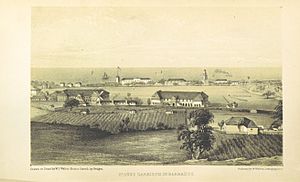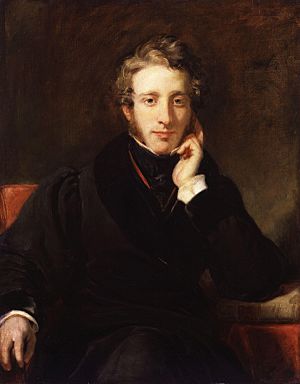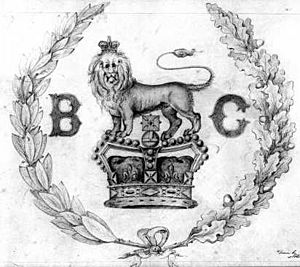Richard Clement Moody facts for kids
Quick facts for kids
Richard Clement Moody
|
|
|---|---|
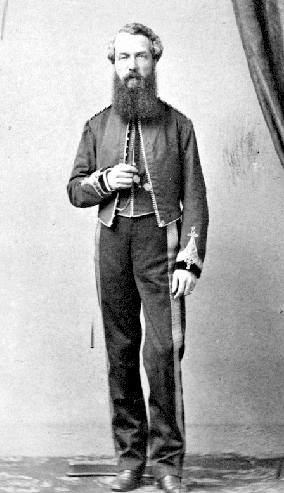
Richard Clement Moody, 1859
|
|
| Governor of the Falkland Islands | |
| In office 1 October 1841 – July 1848 |
|
| Monarch | Queen Victoria |
| Preceded by | None (Moody inaugural holder) |
| Succeeded by | George Rennie |
| Lieutenant-Governor of British Columbia | |
| In office 25 December 1858 – July 1863 |
|
| Monarch | Queen Victoria |
| Preceded by | None (Moody inaugural holder) |
| Succeeded by | Frederick Seymour |
| Personal details | |
| Born | 13 February 1813 St. Ann's Garrison, Bridgetown, Barbados |
| Died | 31 March 1887 (aged 74) Bournemouth, England |
| Resting place | St Peter's Church, Bournemouth. |
| Nationality | British |
| Spouses | Mary Hawks, daughter of Joseph Hawks JP DL, Sheriff of Newcastle-upon-Tyne. Married 1852. |
| Relations |
|
| Children | 13, 11 of which survived infancy, including: |
| Parents | Colonel Thomas Moody, Kt.; Martha Clement (1784–1868) |
| Residences | Government House, New Westminster |
| Education | Homeschooled |
| Alma mater | Royal Military Academy, Woolwich |
| Occupation | Soldier; Engineer; Politician; Architect. |
| Military service | |
| Allegiance | |
| Branch/service | Royal Engineers |
| Rank | Major-General |
| Commands |
|
Richard Clement Moody (born February 13, 1813 – died March 31, 1887) was a British soldier, engineer, and governor. He is famous for being the first British Governor of the Falkland Islands. He also founded and became the first Lieutenant-Governor of British Columbia in Canada. People called him an 'Empire builder' because of his important work in these places.
Moody was chosen to help create the Colony of British Columbia. The British government wanted to build a "second England" on the Pacific coast. They saw Moody as a perfect example of a 'British Officer' and 'English gentleman'. He led the Royal Engineers, Columbia Detachment and was the Chief Commissioner of Lands and Works.
He is seen as a founding father of British Columbia. He chose the location for and established New Westminster, the first capital. He also helped build the Cariboo Road and create Stanley Park. He named Burnaby Lake after his secretary, Robert Burnaby. He also named "Mary Hill" in Port Coquitlam after his wife, Mary. Port Moody and Moody Park are named after him.
Moody was also the first British Governor of the Falkland Islands. He planned and built settlements there. He chose the site for and founded Port Stanley, the capital of the Falkland Islands. Moody Brook in the Falkland Islands and Moody Point in Antarctica are named after him.
Contents
Early Life and Family
Richard Clement Moody was born in 1813 in St. Ann's Garrison, Barbados. He was the third of ten children. His father was Colonel Thomas Moody, a well-known British officer. His mother was Martha Clement. Richard Clement was named after his Dutch grandfather, Richard Clement.
His family was important in the British Empire. His brother, Colonel Hampden Clement Blamire Moody, was a commander of the Royal Engineers in China. His son, Colonel Richard Stanley Hawks Moody, also became a distinguished soldier.
A Talented Young Man
Richard Clement Moody was very talented in many areas, like math, music, and drawing. He loved both science and art. He joined the Royal Military Academy, Woolwich at age 14. He became the Head of School the next year and finished his studies quickly.
He even created plans for restoring Edinburgh Castle using musical ideas. These plans impressed Queen Victoria and Prince Albert, who were both musicians. They were very happy with his ideas. People called him a 'visionary' because of his unique way of thinking.
Military and Civil Career
Richard Clement Moody joined the Royal Engineers in 1830 as a Second Lieutenant. He rose through the ranks, becoming a Lieutenant-Colonel in 1855 and a Major-General in 1866.
He worked on surveys in Ireland and served in St. Vincent. He also taught at the Royal Military Academy, Woolwich.
Governor of the Falkland Islands
In 1841, at just 28 years old, Moody was appointed the first Lieutenant-Governor of the Falkland Islands. This was a very important job for such a young man. He arrived in 1842, finding the islands in a state of disorder. He worked hard to develop the islands' basic services and buildings.
Moody wrote a report for the British government, suggesting they encourage settlers and sheep farming. He also became friends with the botanist Joseph Dalton Hooker, who praised Moody's efforts to improve the colony.
Founding Stanley
Soon after arriving, Moody was advised by explorer Sir James Clark Ross to choose a better location for the capital. Moody agreed and selected a site he named Port Stanley, after Lord Stanley, a government official. He founded and developed this new city. The government offices moved there in 1845.
Moody designed Government House in Stanley. Today, Moody Point in Antarctica is named after him. He also introduced tussock grass from the Falklands to Great Britain, which earned him an award.
Moody established a local government with a Legislative Council and an Executive Council. He also created laws, collected taxes, and kept order. He asked for a doctor, a judge, and a chaplain for the islands. His brother, James Leith Moody, became the chaplain. Moody built homes, offices, roads, docks, a court, a jail, a school, and a police force.
In 1845, he even raised a local militia (a group of citizens trained as soldiers) to protect the islands. This militia later became the Falkland Islands Defence Force. Moody's time as governor was very successful for the British government.
Life in Britain and Malta
After leaving the Falkland Islands in 1848, Moody returned to England. He worked for the Colonial Office and served at Chatham Dockyard. In 1852, he became the Commanding Royal Engineer of Newcastle upon Tyne. He helped manage the relief efforts after a reservoir burst in Yorkshire.
During the Crimean War in 1854, Moody was an Executive Officer in Malta. His eldest son, Richard Stanley Hawks Moody, was born there. However, Moody had to leave his post in 1855 due to illness.
He then became the Commander of the Royal Engineers in Scotland. While there, he enjoyed the intellectual life of Edinburgh and worked on architectural projects.
Founding British Columbia
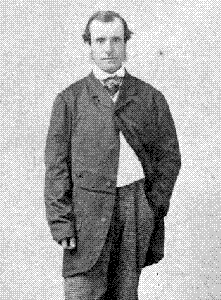
When gold was discovered in the Fraser Canyon Gold Rush in Canada, the British government decided to create the Colony of British Columbia (1858–66). Sir Edward Bulwer-Lytton, the Secretary of State for the Colonies, chose Moody to lead a group of 172 Royal Engineers. Moody was selected because of his military experience, his success in the Falkland Islands, and his family's good reputation.
His mission was to establish British law and order and to turn the new colony into a strong British presence on the Pacific coast. Lord Lytton wanted to send the "best of British culture" to the colony, not just a police force. He saw Moody as the ideal 'English gentleman and British Officer'.
Moody, his wife Mary, and their four children left England in October 1858. They arrived in British Columbia in December 1858 with the Royal Engineers. Moody became the first Lieutenant-Governor of British Columbia and Chief Commissioner of Lands and Works. He hired Robert Burnaby as his personal secretary.
Handling Challenges
When Moody arrived, he faced a problem called "Ned McGowan's War". A group of gold miners led by Ned McGowan was causing trouble. Moody managed to stop the conflict without anyone getting hurt. He was praised for his success in bringing peace.
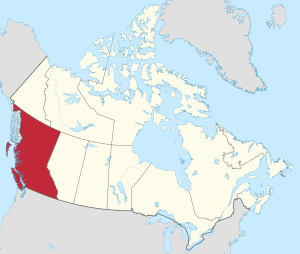
Building New Westminster
In British Columbia, Moody wanted to create a beautiful city in the wilderness. He chose the site for the new capital, New Westminster, because of its good location and excellent port. He was also impressed by the natural beauty of the area, describing the mountains and rivers.
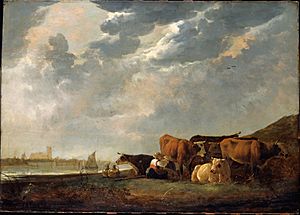
Moody founded New Westminster, but there were challenges with funding. His Royal Engineers worked hard to build roads and settlements. They built Kingsway (connecting New Westminster to False Creek), the North Road, and the Pacific railway terminus at Port Moody. They also established the Cariboo Road and set aside land for Stanley Park.
He named Burnaby Lake after his secretary, Robert Burnaby. He named "Mary Hill" in Port Coquitlam after his wife, Mary. Port Moody was also established by him to protect New Westminster.
Moody designed the first Coat of arms of British Columbia. He was well-liked by the colonists and respected by the government in London.
Challenges with Governor Douglas
During his time in British Columbia, Moody faced difficulties working with Sir James Douglas, the Governor of Vancouver Island. Their roles sometimes overlapped, and they had different ideas about how to develop the colony. Moody's supporters believed that Douglas's actions sometimes slowed down Moody's work. Despite these challenges, historians generally praise Moody's achievements in British Columbia.
Leaving British Columbia
The Royal Engineers group was disbanded in July 1863. Moody, his family, and some of the Engineers returned to England. Many of the Engineers chose to stay in British Columbia. People in New Westminster gathered to say goodbye to Moody, showing how much they appreciated him. Moody always hoped to return to British Columbia, but he never did. He left his personal library in New Westminster for the public to use.
After Moody left, New Westminster honored him by naming Moody Square and Moody Park after him. A monument in his honor was unveiled in Moody Park in 1984. In 2014, a photograph album that belonged to Richard Clement Moody was purchased by the Royal British Columbia Museum. It contains early photos of British Columbia and its people.
Later Life in Britain
Moody arrived back in England in December 1863. He continued his engineering work at Chatham Dockyard until 1866. In January 1866, he was promoted to Major-General and then retired from the Army.
After retiring, Moody served as a Municipal Commissioner. He was also a member of several important societies, including the Institution of Civil Engineers, the Royal Geographical Society, and the Royal Agricultural Society of England. He was friends with famous people like the writer Edward Bulwer-Lytton and the biologist Joseph Dalton Hooker.
Richard Clement Moody passed away on March 31, 1887, in Bournemouth, England. He was buried at St Peter's Church, Bournemouth. He left behind a significant amount of money and property.
Images for kids
See also
 In Spanish: Richard Moody para niños
In Spanish: Richard Moody para niños


